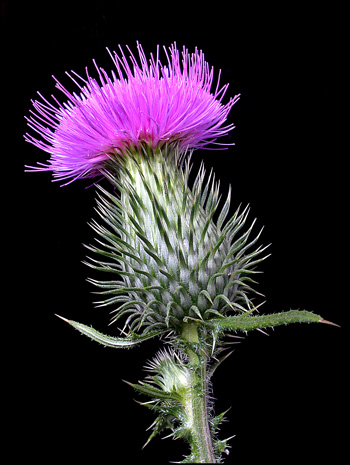
|
A Close-up View of Two Thistles: (Cirsium vulgare & Carduus nutans) by Brian Johnston (Canada) |

|
A Close-up View of Two Thistles: (Cirsium vulgare & Carduus nutans) by Brian Johnston (Canada) |
The ubiquitous thistle flamboyantly discourages close investigation. Almost the entire plant is covered in very sharp spiny bristles that easily penetrate all but the most sturdy materials. Strange as it may seem, certain species of deer have been observed munching on the leaves and stems of these most unappetizing wildflowers!
The Bull Thistle (Cirsium vulgare)
The Bull thistle seen above has the scientific name Cirsium vulgare. Cirsium is derived from the Greek for 'swollen vein' because this plant was used many years ago in the treatment of this affliction. Thistles are members of the Aster family. Unlike the sunflower and New England aster (the subject of an earlier article), the thistle has no ray flowers, but many disk flowers that are usually bright pinkish-purple. Beneath the flower head are hundreds of grayish-green bracts (modified leaves), each tipped with a very sharp, stiff yellow spine. Notice in the image below, how the upper bracts curve up towards the flower head, while the lowest ones bend down.

In the following images, taken from two different angles, the spiny tips of the bracts are clearly visible.


Below the bracts is a very immature flower-head. It is obvious from the following image that the entire plant has evolved an extraordinary defence strategy. Every surface is protected by viciously sharp spines. (To take the photographs in the article, I used a combination of leather gloves and two sturdy tweezers to position the plant! Even with this protection, I received several punctures that took days to heal.)

At the peak of its blooming cycle, the Bull thistle flower-head is a magnificent sight. The image below shows the large dome of disk flowers. Since the thistle is a composite plant, each of the pink projections is an individual flower. You are looking at not one flower, but hundreds! To the right of the bloom is an immature flower-head which would have bloomed in about a week.

A side view of the plant above shows the 'cap' shape of the flower-head. If you compare the base of the flower below with that in the first photograph in the article, you will see subtle differences. The shape is different, and the downward bending bracts are missing here. Blooms on the same plant may show these differences, as may plants growing side by side. I am not certain why these differences in shape occur within a plant, however separate plants may differ because the thistle is prone to hybridization. (Pollen from a different species pollinates a plant, resulting in seeds having characteristics of both species.)

The colour of the Bull thistle bloom is also variable. The image below shows a more deeply coloured flower-head than the previous example. Although an almost white colouration has been reported, all of the examples that I have observed have been a shade of pinkish-purple. The bloom below is particularly large at about 5 cm diameter.

Disk flowers are packed so closely in the bloom that it is almost impossible to see an individual flower. The photomicrograph on the left below shows three of the five petals (which are fused at the base) and the bottom of the anther. The image on the right shows a closer view. Notice the prickly white pollen grain at the centre of the image. (All photomicrographs used dark-ground illumination.)


Two images of the midpoint of an anther show the rough surface, and another pollen grain in the left image.


A less perfect pollen grain can be seen clinging to the surface of part of the stigma of the plant.

Before the flowers bloom, the bracts are packed into a spherical or elliptical shape. The tips of the bracts of this particular plant are purple in colour.

These bract tips can be seen more highly magnified in the image below. If you compare the photograph with the earlier one of another plant, it is obvious that there are considerable differences. As far as I can determine, the two plants are both Bull thistles. If any knowledgeable reader can shed more light on this mystery, I would be happy to hear from you!

The stems and leaves of many plants are covered with more than just spines. Fine cobweb-like threads cover portions in a white shroud. The cause appears to be the insect captured in the image below. The head is on the left, and is blurred because of movement as it generates the 'web'.

The Nodding Thistle (Carduus nutans)


Like the Bull thistle, this plant was introduced from Eurasia in the early nineteen hundreds. Its name is derived from the fact that as the blooms mature, they droop or nod towards the ground. (The two images above reveal a common problem in the macrophotography of plants. Digital cameras tend to have a much greater depth of field than their SLR or DSLR counterparts. This results in much of the foreground and background being in focus, as well as the subject. The subject therefore, doesn't stand out clearly. It is for this reason that I have chosen to use a black background in the images in this series of articles about wildflowers.)
The ring of bracts beneath the flower head in this species is a different shape, having less depth than in the Bull thistle.
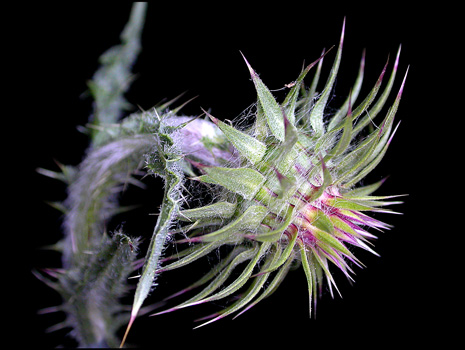
The image below shows a mature bloom. This is a particularly 'droopy' example!
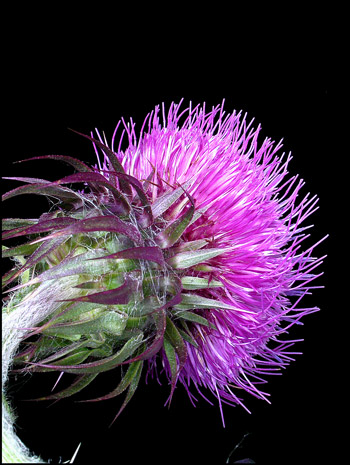
Notice, in the following image, the very fine thread-like fibers that encircle the bract structure.
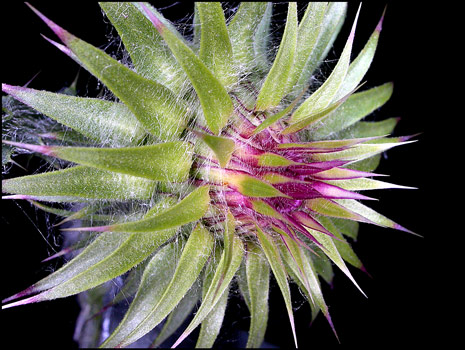
The stem of the plant is also covered with these fine white fibers. As can be seen below, this species also grows magnificent spines.
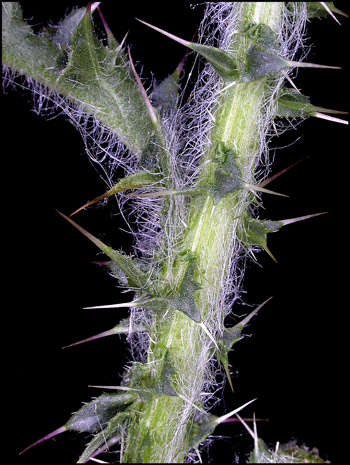
Although both species of thistle illustrated in this article are a serious problem for farmers, they are both quite beautiful. In addition, their blooms supply nectar to honey bees, and eventually, seeds as food for many birds. They display one of the finest defense strategies in the world of plants. Take a closer look the next time you notice a thistle - but do take care!
Photographic Equipment
The low magnification photographs in the article were taken using a Nikon Coolpix 4500 with natural light and the Nikon Cool light SL-1. Higher magnification images were taken using a Sony CyberShot DSC-F 717 equipped with an accessory achromat which screws into the 58 mm filter threads of the camera lens. (This produces a magnification of from 7X to 9X for a 4x6 inch image.) Still higher magnifications were obtained by using a macro coupler (which has two male threads) to attach a reversed 50 mm focal length f 1.4 Olympus SLR lens to the F 717. (The magnification here is about 13X for a 4x6 inch image.) The photomicrographs were taken with a Leitz SM-Pol microscope (using a dark ground condenser), and the Coolpix 4500.
All comments to the author Brian Johnston are welcomed.
Published in the June 2004 edition of Micscape.
Please report any Web problems or offer general comments to the Micscape Editor.
Micscape is the on-line
monthly magazine of the Microscopy UK web
site at
Microscopy-UK
© Onview.net Ltd, Microscopy-UK, and all contributors 1995 onwards. All rights reserved. Main site is at www.microscopy-uk.org.uk with full mirror at www.microscopy-uk.net.